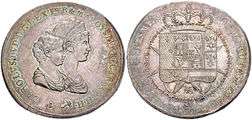Tuscan pound
The pound (Italian: lira) was the distinct currency of Tuscany until the annexation by Napoleonic France in 1807. After that year, it unofficially remained in circulation thanks to its silver value until the restoration of Tuscan independence in 1814. It was finally abolished in 1826.
| Tuscan pound | |
|---|---|
| lira (Italian) | |
 10 pounds by Charles Louis | |
| Denominations | |
| Subunit | |
| 1⁄60 | quattrino |
| Symbol | £ |
| Coins | q.1, q.2, s.1⁄2, s.1, s.2, q.10 £1, £5, £10 |
| Rarely used | £20, £40 |
| Demographics | |
| User(s) | |
| Issuance | |
| Mint | Florence Mint |
This infobox shows the latest status before this currency was rendered obsolete. | |
It was subdivided into 20 shillings (Italian: soldo), each of 3 quattrini (singular: quattrino) or 12 pennies (Italian: denaro), with the paolo worth 40 quattrini and the francescone worth 10 paoli. It was replaced by the florin, worth 100 quattrini or 1 2⁄3 pounds. In 1803 the pound contained 3.66 grams of silver.
Coins
In the late 18th century, copper coins circulated in denominations of 1 and 2 quattrini, and 1 shilling, together with billon 10 quattrini and silver 1⁄2, 1, 2, 5 and 10 paoli. In the early 19th century, copper 1⁄2 and 2 shillings were added, together with silver 1 and 10 pounds.
References
- Krause, Chester L.; Clifford Mishler (1978). Standard Catalog of World Coins: 1979 Edition. Colin R. Bruce II (senior editor) (5th ed.). Krause Publications. ISBN 0873410203.